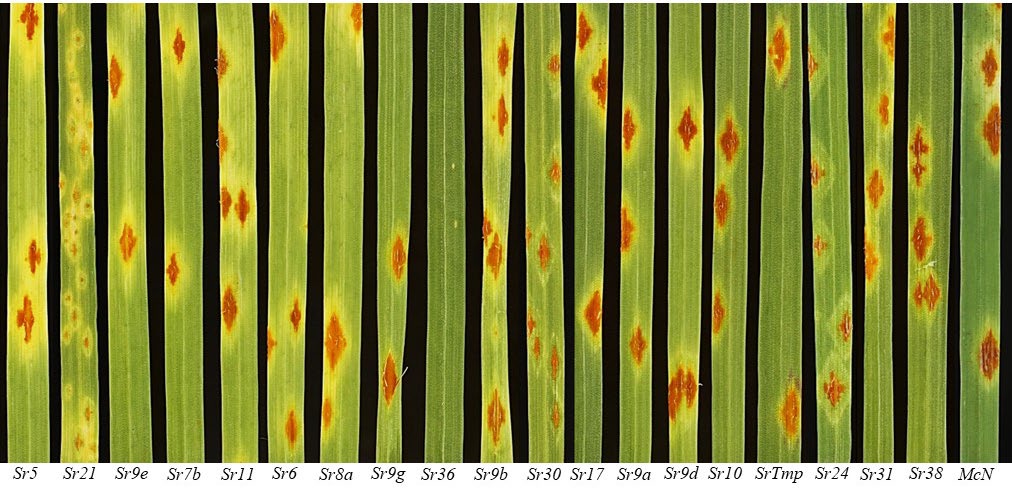GRRC report of yellow and stem rust genotyping and race analyses 2022
This report presents results from molecular genotyping and race typing based on samples of rust infected wheat, barley and triticale collected in 2022 across four continents, i.e., Europe, Asia, Africa and South America.

The report comprises results for wheat yellow/stripe rust (Puccinia striiformis) and wheat stem rust, P. graminis f.sp. tritici. The testing of additional samples from 2022 and 2023 is ongoing with emphasis on alignment of results from different rust diagnostic laboratories and genotyping approaches with the aim of presenting the global landscape for yellow and stem rust infecting wheat.
In 2022, a total of 833 samples/derived isolates from 20 countries were handled. Each sample generally consisted of multiple rust infected leaves or stems. Incoming rust samples entered a recovery procedure in parallel to Simple Sequence Repeat (SSR) genotyping. More than 350 samples were successfully recovered. In case of detection of more than a single genotype within a sample, additional genotyping was based on purified samples. Subsets of recovered isolates were race phenotyped using bioassays consisting of differential wheat lines inoculated with live spore samples multiplied under strict experimental conditions.
Key highlights stem rust
-
Clade I (Ug99) was not observed outside East Africa, however, two new races with reduced virulence to Sr21 were detected in Kenya.
-
Clade III-B (race TTRTF) was widespread in southern part of Europe, and recently detected in Tunisia, Switzerland and Sweden. Since its detection in Sicily in 2016, TTRTF has been confirmed in 10 countries in Europe, and in 4 countries in Africa/Asia.
-
Clade IV-B (races TKTTF, TKRTF and TTTTF) was observed in Tanzania and Tunisia and in 9 European countries in 2021 and 2022. TKRTF was observed in a single isolate from Spain; TTTTF was observed in East Africa but not in Europe.
-
Clade IV-F (races TKKTF, TKFTF) was detected in 4 African countries in 2021-2022, and widespread in Europe (14 countries). Previously, race TKKTF has been detected in Azerbaijan, Egypt, Iran, Iraq and Tajikistan. Race TKFTF was not detected outside of Europe.
-
Two genetic groups were prevalent in Europe in 2021-2022, Clade IV-B, and Clade IV-F. Significant spread has been observed in recent years, particularly in France, but also in other countries in Central/West Europe and Africa.
Key highlights yellow rust
-
PstS16 became widespread in Ethiopia in 2021-2022 after exotic incursion from Asia in 2020. An additional incursion was detected 2021-2022, but the new genotype remained at low frequency.
-
PstS17 (new named group, provisionally termed “ME2018) was detected in East Africa (Ethiopia) for the first time. This group has been detected in the Middle East since 2018, but in 2021-2022 also detected at low frequency in the Baltic states.
-
Genetic group PstS13, which is widespread on several continents, was detected for the first time in Northern Africa (Tunisia). A single race/genotype is prevalent in this group although local variants have been observed.
-
PstS10 was the most prevalent genetic group in Europe. At least 4 races were detected, each adapted to local, widely grown wheat varieties.
-
PstS11 and PstS1/2 were confirmed in multiple countries in East Africa.
-
Additional genetic groups, including groups which have not yet been named (collectively termed ‘Other’), were either absent or detected in low frequencies.
-
Samples from Nepal 2021-2022 were genetically different from previous named groups, revealing many genotypes of which some were dominating.
You can find the results on maps and charts via these direct links:
Contact
E-Mail: mogens.hovmoller@agro.au.dk
E-Mail: jensg.hansen@agro.au.dk
